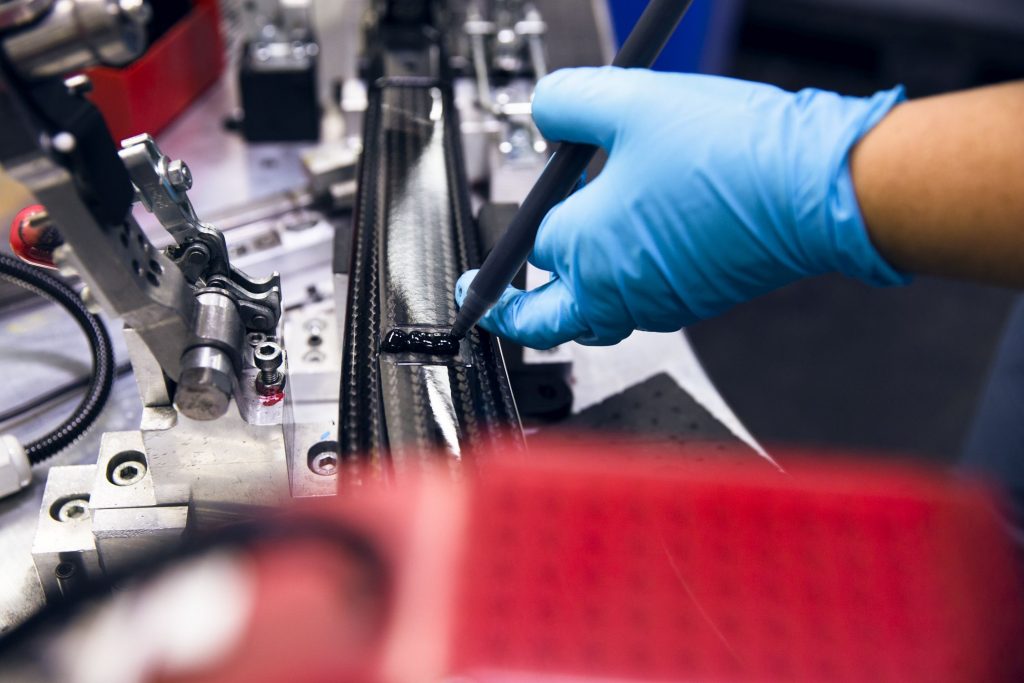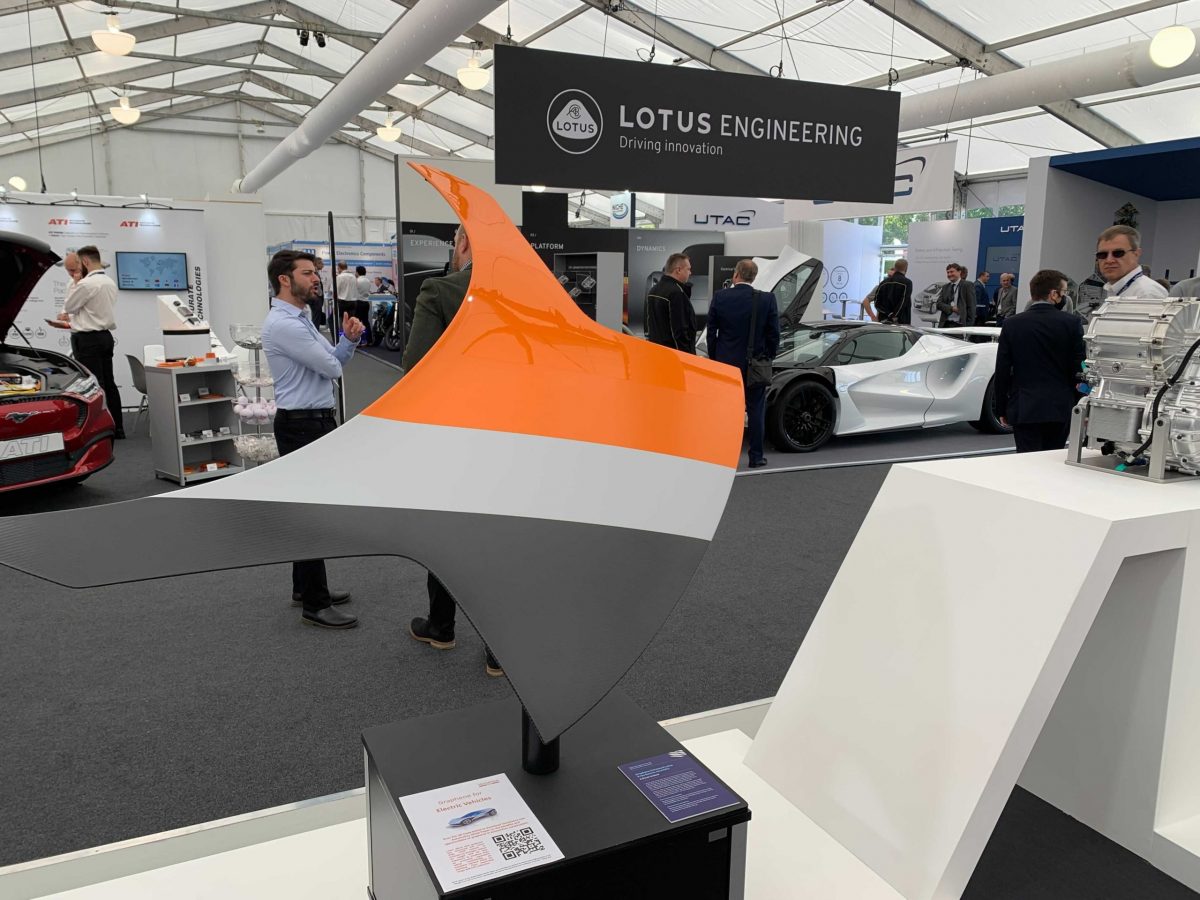

Working in Tandem
The strength, durability and light weight of composites have made them the material of choice for many applications in aerospace, automotive and other industries. But composites can’t always provide all the properties that customers need for specific applications. Combining them with steel, aluminum or other materials often yields the ideal solution.
Creative Composites Group’s (CCG) GFRP rail platforms and bridge decks are installed throughout the U.S. But when it came to joining the different sections together, the company realized that they needed metal reinforcement to form a secure connection. A bolt put into a composite part will pull out at a lower load than a bolt put into a steel part.
Years ago, CCG started embedding carbon steel plates along the edges of GFRP panels during the vacuum infusion process, using a primer on the steel to strengthen its chemical adherence to the resin. Threaded bolt holes are then drilled in the GFRP/steel edge. Installation crews use external hardware to attach the FRP panels to support the structure and join the FRP sections together in the field, then seal the hole with caulk to try to prevent water intrusion.
However, since water tends to seep in despite these precautions, CCG switched from carbon steel to stainless steel for the reinforcement plates. “Composites are generally at a premium price over steel or concrete, and part of the value that we’re selling is longevity,” says Scott Reeve, business development for CCG. “You want to have the steel on the inside of a product to be a type that’s going to last as long as the FRP.”
The company also embeds steel into composite components that require added stiffness, such as extended cantilevered structures. “The basic structure is composites, which keeps the weight down and keeps the corrosion resistance, but there are steel channels totally encapsulated in the FRP. It’s the most economical use of the two materials,” says Reeve.
In the past, CCG has also used thin steel strands instead of glass or carbon fibers when manufacturing FRP components for certain applications. This provides added stiffness while reducing thickness, since fewer layers of the steel-fiber-reinforced composite are required. The drawback to this material is that the steel fibers provide reinforcement only in one direction; they don’t have the multi-directional properties of composites reinforced with other types of fiber.
Reeve says that owners of vehicle bridges with composite railings often request that steel reinforcements be placed inside railings. If a vehicle hits the structure, bridge owners are more comfortable knowing that the load from the impact will be transferred to the steel – a material they’re familiar with – rather than to the composites, which they may not know as well. Although engineers are growing more knowledgeable about composites, the multi-material approach provides extra reassurance, adding the longevity of composites with the known strength of steel.
Finding the Right Combination
In the automotive industry, companies like SGL Carbon and Katcon are designing and producing multi-material battery enclosures for electric vehicles (EVs).
One of SGL’s first projects was the development and prototype production of the battery case for the NIO electric smart car. The materials included extruded aluminum for the side rails, composites for the top and bottom plates, and steel for the mounting parts. The combination was chosen to meet weight targets, performance requirements and crash behavior.
“In general, in the field of battery enclosures, metallic parts are used for the load introduction as well as for crush zones, while the composite overtakes the load distribution,” says Dan Gillig, SGL’s North American technical sales manager.
When developing a mixed material component, SGL considers not only the process of combining the different materials but also how to prevent problems like galvanic corrosion during the vehicle’s lifetime. The design takes into account the different materials’ properties, how they react to specific forces and the load transfer/distribution between parts.
SGL varies its joining technologies according to the materials used and the specific part’s function. Liquid adhesive technology, for example, is important not only to attach the parts to each other but also to carry loads and avoid the creation of weak spots in the assembly. Some assemblies are supported by bolting or riveting, which provides a local mechanical connection in an area where adhesive bonding is carrying the load transfer. Inserts directly integrated into the composite structure or easily bonded threaded studs are often used for mounting points in the assembly when lower loads are being transferred.
Katcon, based in Santa Catarina, Mexico, has worked with Forward Engineering in Munich, Germany, to develop a toolbox of materials, processes and design knowledge that’s intended to help manufacturers achieve the best configuration for their specific battery electric vehicle (BEV) platforms. “The goal is to have a lighter battery enclosure that is also economically feasible, safe and sustainable and that can be mass produced,” says Juan Armendariz, Katcon’s general manager.
“We found that steel and composites make a great combination,” he says. “We use the steel in the structural members. We use the composites for large panels that are typically expensive to produce in steel due to machinery, tooling and the associated capital expenditures. We can produce those parts more effectively with composites, and the composites are very well suited for intrusion resistance and fire resistance.”
Steel is a good choice in combination with composites because it is cost effective for large-scale production, has excellent fire-resistance and OEMs are already familiar with it, adds Armendariz.
When designing the battery enclosure, “we need to be very aware of the parts count and the job each component is doing. When you approach this with the whole picture in mind, you get to choose where you want those joints, where they are least exposed and where they add more value,” he says.
In most cases, Katcon uses both mechanical connections and adhesives in the joints. Although mechanical fastenings add some complexity, Armendariz doesn’t expect that the industry will switch entirely to an adhesive solution anytime soon.
“It’s not just about lightweighting; it’s also being efficient with material allocations, energy utilization and the need to be sustainable. So, the optimal combination is when we use adhesives in combination with other joining methods,” he explains.
In the future, Armendariz expects to see greater use of multi-material components throughout vehicles. “In the end, I think that’s going to help us design better vehicles, grow efficiencies and be more sustainable,” he says.
Better Solutions for Bonding
In 2014, researchers working on a composites technology roadmap for the National Institute of Standards and Technology questioned manufacturers about the areas of research they were most interested in. Finding the best way to join composites with other materials was one of their top three concerns. Established in July 2021 at the Georgia Tech Manufacturing Institute, the Center for Composite and Hybrid Materials Interfacing (CHMI) will research this topic through a five-year, renewable grant from the National Science Foundation’s (NSF) Industry-University Cooperative Research Center (IUCRC) program.
The three universities involved – Georgia Tech, Oakland University in Michigan (OU) and the University of Tennessee, Knoxville (UTK) – will collaborate with members of an industry consortium to develop and disseminate methods, technologies and tools that facilitate rapid, reliable and cost-effective composite and hybrid materials joining and interfacing. CHMI’s goal over the next 10 years is to reduce, by at least 50%, the cost, cycle time and variation of these operations.
Industry input is built into the project. Consortium members vote on which projects to pursue, and they fund the research through their membership fees. In addition, company representatives will serve as mentors to review progress and guide the project research. Each university has a different industry focus – Georgia Tech on aerospace, OU on automotive and UTK on infrastructure and medical devices.
In aerospace, the push for lighter weight aircraft has increased the need for better composites and multi-material joining solutions, says Chuck Zhang, CHMI’s director and the Harold Smalley Professor in Georgia Tech’s H. Milton Stewart School of Industrial and Systems Engineering. Airlines know how to repair and maintain older, mostly metal aircraft like the 737 and 757. But they lack the expertise required for the newer Boeing 787 and Airbus A350, in which more than half of the structure by volume is composite materials. Many of these repairs involve aircraft sections where composite components are used in conjunction with components manufactured from other materials.
“People in the aircraft maintenance field tell me that they have very limited knowledge of how to repair these. If there’s minor damage, they can patch it, but if there’s major damage – like a big hole in the wing or fuselage – they normally have to go back to the OEMs,” Zhang says. That can quickly drive up the airline’s repair and maintenance costs.
Manufacturers of these aircraft have their own concerns about multi-material components. For example, when they drill holes and use mechanical fasteners to join composite materials with aluminum or steel, the composite materials may get damaged and lose strength.
Zhang says that CHMI researchers originally thought their focus would be on creating advanced adhesives that would eliminate the need for mechanical fasteners. But the airline industry representatives pointed out that the FAA requires both adhesive and mechanical fastening for multi-material joints. So, one area that CHMI research teams could focus on is developing computational models, process control and non-destructive testing methods that could help change those requirements. They might test adhesives and processes on a repair for subscale, such as a 3 x 3-foot composite/metal structure, and then use modeling to predict how feasible this solution would be on a larger scale.
CMHI researchers and their industry partners also hope to find ways to increase automation of the composite/metal joining process during both manufacturing and repair. This will be easier to achieve in the manufacturing plant, where work can be standardized, than in the field, where repairs to a composite or multi-material aircraft may be required in many places.
For instance, the researchers might study robots like those developed by Lufthansa Technik as part of its CAIRE Project (Composite Adaptable Inspection and Repair). The mobile robots can cling to aircraft wings and fuselages to inspect and repair the composite structures by scanning and recording damages, removing damaged materials and producing customized repair layers, says Zhang.
The creation of CHMI comes at a good time for the composites industry. As demand for multi-material solutions continues to grow, manufacturers will need to find ways to ensure that customers who choose mixed material solutions will benefit from the desirable properties that each material offers.
Mary Lou Jay is a freelance writer based in Timonium, Md. Email comments to mljay@comcast.net.

SUBSCRIBE TO CM MAGAZINE
Composites Manufacturing Magazine is the official publication of the American Composites Manufacturers Association. Subscribe to get a free annual subscription to Composites Manufacturing Magazine and receive composites industry insights you can’t get anywhere else.




